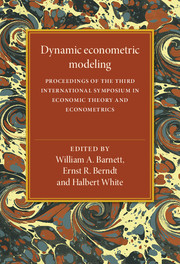 Dynamic Econometric Modeling
Dynamic Econometric Modeling Book contents
- Frontmatter
- Contents
- Editors' introduction
- List of contributors
- Part I Dynamic structural modeling
- 1 Efficient instrumental variables estimation of systems of implicit heterogeneous nonlinear dynamic equations with nonspherical errors
- 2 Envelope consistent functional separability
- 3 Flexible functional forms for profit functions and global curvature conditions
- 4 Likelihood inference in the nonlinear regression model with explosive linear dynamics
- 5 Exact inference in models with autoregressive conditional heteroscedasticity
- 6 Control of a linear regression process with unknown parameters
- 7 Some tests of nonparametric regression models
- Part II Linear time series modeling
- Part III Chaotic attractor modeling
- Part IV Applications
1 - Efficient instrumental variables estimation of systems of implicit heterogeneous nonlinear dynamic equations with nonspherical errors
Published online by Cambridge University Press: 03 May 2010
- Frontmatter
- Contents
- Editors' introduction
- List of contributors
- Part I Dynamic structural modeling
- 1 Efficient instrumental variables estimation of systems of implicit heterogeneous nonlinear dynamic equations with nonspherical errors
- 2 Envelope consistent functional separability
- 3 Flexible functional forms for profit functions and global curvature conditions
- 4 Likelihood inference in the nonlinear regression model with explosive linear dynamics
- 5 Exact inference in models with autoregressive conditional heteroscedasticity
- 6 Control of a linear regression process with unknown parameters
- 7 Some tests of nonparametric regression models
- Part II Linear time series modeling
- Part III Chaotic attractor modeling
- Part IV Applications
Summary
Introduction
First used by the zoologist Sewall Wright (1925), the method of instrumental variables (IVs) was initially given a formal development by Reiersøl (1941, 1945) and Geary (1949). It is now one of the most useful and widely applied estimation methods of modern econometrics. Major contributions to the early development of this method in econometrics are those of Theil (1953), Basmann (1957), and Sargan (1958) for systems of linear simultaneous equations with independent identically distributed (i.i.d.) errors. A major concern of this development was to make efficient use of the available instrumental variables by finding instrumental variables estimators that have minimal asymptotic variance.
This concern is also evident in the subsequent work of Zellner and Theil (1962), Brundy and Jorgenson (1974), and Sargan (1964), who consider contemporaneous correlation in linear systems; Sargan (1959), Amemiya (1966), Fair (1970), Hansen and Sargent (1982), and Hayashi and Sims (1983), who consider specific forms of serial correlation for errors of linear equations or systems of equations; and Amemiya (1983), Bowden and Turkington (1985), and White (1984, Chapter 7), who consider specific forms of heteroscedasticity. For systems of linear equations White (1984, Chapter 4; 1986) considers general forms of nonsphericality in an instrumental variables context. Investigation of the properties of instrumental variables estimators in nonlinear contexts was undertaken in seminal work by Amemiya (1974, 1977) for single equations and for systems of nonlinear equations with contemporaneous correlation.
- Type
- Chapter
- Information
- Dynamic Econometric ModelingProceedings of the Third International Symposium in Economic Theory and Econometrics, pp. 3 - 26Publisher: Cambridge University PressPrint publication year: 1988
- 2
- Cited by
